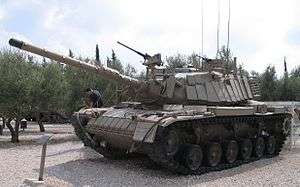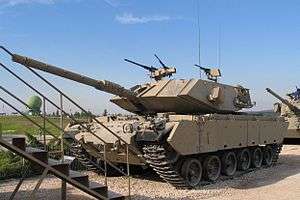Magach

Magach (מגח; Ma-GAKH) designation refers to a series of tanks in Israeli service. The tanks are based on the American M48 and M60 Patton tanks. Magach 1, 2, 3 and 5 are based on M48 tanks; Magach 6 and 7 are based on M60 tanks.
Service history
The tanks were sold to the Israel Defense Forces (IDF) by West Germany (and later by the United States) during the 1960s and 1970s. Several dozen Jordanian M48 tanks, captured intact during the 1967 Six Day War, were also commissioned, adding to the 150 already in service at that time. During the war, the Israeli tanks served in their original (American) configuration.
Following the 1967 war, several modifications were made to improve the tank to M48A3 level, resulting in the Magach 3. These modifications included replacing the original 90 mm gun with the British 105 mm L7, lowering the command turret's profile, upgrading the communication suite, and replacing the weak gasoline engine, that was susceptible to fire, with a 750 hp diesel one.
When the Yom Kippur War broke out, Israel had 540 M48A3 (with 105mm gun) and M60A1 tanks.[1][2] During the war, the tanks suffered heavy losses. The location of flammable hydraulic fluid at the front of the turret was discovered to be a severe vulnerability. After the war, Israel had only about 200 M48A3 and M60A1 tanks, after a large number of Israeli tanks were destroyed or terminally hit during the war, mostly in the Sinai front against entrenched Egyptian infantry armed with AT-3 Sagger anti tank missiles.[1] War losses were replaced with new M48A5 (Magach 5) and M60 (Magach 6) during the 1970s.
Prior to the 1982 invasion of Lebanon (1982 Lebanon War), Magach 6 tanks were fitted with explosive reactive armor (ERA). Further work has been done on the upgraded Magach 6 models, including new armor, Merkava-based tracks, new fire controls, a thermal sleeve for the gun and smoke dischargers, eventually resulting in the Magach 7 model, which is still in use with the IDF.
Since the 1980s and 1990s, the Magachs have been gradually replaced by Merkava tanks as Israel's front-line main battle tank. However, a large majority of the IDF's armored corps continued to consist of Magach variants until the 1990s, and the tank was continuously upgraded during this time.
By 2006, all Magachs in regular units had been replaced by Merkavas.
In July 2015, Israel officially unveiled the existence of the Pereh missile carrier. The Pereh is a guided missile carrier disguised as a tank.[3] A Magach is converted into a Pereh tank destroyer by replacing the main battle gun with an anti-tank guided missile launch station. The original turret is enlarged to install a launcher under armor for 12 "Tamuz" Spike NLOS missiles, which can destroy targets out to 25 km (16 mi). Disguised as a standard tank, the Pereh is fitted with a fake cannon barrel to the front, but can be identified easily by the curved antenna mounted at the rear on the roof of the turret, which is erected in firing position; additional features include add-on frontal armor and stowage boxes on the turret sides. Pictures of the Pereh were first released during Operation Protective Edge in July 2014.[4]
Source of the name "Magach"
Contrary to a popular belief, "Magach" is not an abbreviation but a Hebrew word meaning "ramming hit".[5] However, as the word is very rarely used and is not known to many Hebrew speakers, several popular explanations of the name exist:
- Short for Merkevet Giborei Hayil (Hebrew: מרכבת גיבורי חיל, literally Chariot of War Heroes).
- One version states that the real source of the name is the designation M48A3 (in Gematria, 40 is "mem" ("m"), 8 is "chet" ("ch") and 3 is "gimel" ("g")).
- Like the above, but "g" stands for Germany, a supplier of the first M48 tanks to Israel.
- Yet another version says that M48A3 can be read as MAgAch (4 looks like "A", 8 like "g" etc.).
- A once popular macabre joke in the IDF said that "Magach" stands for "Movil Gviyot Charukhot"—"charred bodies carrier", probably referring to the Yom Kippur War losses and particularly to the aforementioned flammable hydraulic fluid problem of the M48.
- Other variants include "Meshupa Gahon" (one with sloping belly) and even "Mechonat Giluach Hashmalit" (electric shaving machine).
Versions

- Magach 1: M48A1.[5]
- Magach 2: M48A2C.[5]
- Magach 3: Modernized M48A1/A2C/A3. The modifications included British 105 mm L7 cannon, low profile commander's cupola, upgraded communication suite, a 750 hp diesel engine Continental AVDS-1790-2A with Allison CD-850-6 transmission. They were eventually fitted with Blazer ERA.
- Magach 5: M48A5 in the original configuration. Generally similar to the Magach 3, but had slightly different engine and transmission—AVDS-1790-2D and CD-850-6A accordingly. They were eventually fitted with Blazer ERA.
- Magach 6: Modernized M60/M60A1/M60A3. Fitted with the Urdan low profile cupola and Blazer ERA.
- Magach 6A (6 Alef): Modernized M60A1. All vehicles were eventually upgraded to the Magach 6B level.
- Magach 6B (6 Bet): Similarly modernized M60A1 RISE (M60A1 with AVDS-1790-2C RISE (Reliability Improved Selected Equipment) engine).
- Magach 6B Gal (6 Bet Gal): Magach 6B with Gal fire control system.
- Magach 6B Gal Batash (6 Bet Gal Batash): Magach 6B Gal fitted with 4th generation passive armor and 908 hp engine. The turret has angled sides and angled mantlet. This variant is sometimes unofficially referred to as Magach 7D or Magach 8. A limited number of vehicles were converted from the Magach 6B Gal variant.
- Magach 6B Baz (6 Bet Baz): Magach 6B fitted with Baz fire control system. A limited number of vehicles were converted from the Magach 6B variant.
- Magach 6C (6 Gimel): Modernized M60A3.
- Magach 6R (6 Resh): Modernized M60, with engine upgraded to the AVDS-1790-2AG level (with more powerful electric generator compared to that of AVDS-1790-2A).
- Magach 6R* (6 Resh*): Magach 6R with preparations for mounting Nachal Oz fire control system.
- Magach 6M (6 Mem): Magach 6R* fitted with Nachal Oz fire control system.
- Magach 7: M60 with 908 hp AVDS-1790-5A engine, additional passive armor, new fire control and Merkava-based tracks. Different configurations exist:
- Magach 7A (7 Alef): Fixed flat mantlet with gun "slots".
- Magach 7B (7 Bet): An interim model with armor configuration similar to the 7C. Apparently never reached production.
- Magach 7C (7 Gimel): Fixed angled mantlet with gun "slots".
- Pereh missile carrier: Guided missile artillery variant armed with the Spike missile.
Magach should not be confused with the Sabra series of upgrade packages for the M60A1/A3, which were developed for export to Turkey. Sabra includes upgrades similar to those of the Magach 7, but an essential difference is that it is armed with the MG251 120 mm smooth-bore gun (the same as used by the Merkava 3).[6]
Operators
See also
Notes
References
- 1 2 "Patton Tanks in Israeli service", Vehicles, Israeli weapons.
- ↑ "Trade register", Arms trade, Sipri.
- ↑ Prigg, Mark (22 July 2015). "Israeli top secret missile launcher disguised as a TANK finally declassified after 30 years of rumors and secret missions". The Daily Mail. Retrieved 24 July 2014.
- ↑ Israel unveils officially existence of "Pereh" based on Magach tank but armed with anti-tank missile - Armyrecognition.com, 22 July 2015
- 1 2 3 Brezner 2008, pp. 23–25.
- ↑ "Sabra M60A3 Main Battle Tank Upgrade". Army Technology. 2011-06-15. Retrieved 2013-12-15.
Bibliography
- Brezner, Amiad (December 2008), "בֵּין גְּבוּלוֹת" [Rammed] (PDF), Shiryon (in Hebrew) (30).
- mass, michael, MAGACH 6B GAL AND GAL BATASH [M60A1 IN IDF SERVICE PAT II] (4).
External links
| Wikimedia Commons has media related to Magach tank. |
- Tsahal [IDF] Miniature: Magach Family
- Israeli weapons: Magach
- Грановский [Granovskiy], Олег [Oleg], Названия, обозначения и количества бронетанковой техники АОИ [Names, Designations and Service Figures of IDF Armored Vehicles] (in Russian), War online
